Having lived abroad for over 10 years, the homesickness for my country’s amazing, delicious and prize-winning cuisine always led me to search for Peruvian restaurants wherever I went.
We moved to Madrid this year, and just two weeks after our move, I had already tried out my first Peruvian restaurant. This place left me so pleasantly surprised that I started recommending it to as many friends as I could. (Hint: it’s the Machupicchu Restaurant near Suanzes.)
As a result, I started being asked for recommendations on what to order and even translations about the unusual names of some of my beloved Peruvian plates (and by translations, I also mean those from Peruvian Spanish to Spain’s Spanish!).
Having repeated myself several times over the past weeks, I thought it would be best to put all this Peruvian cuisine knowledge into a blog post! Hope this will help you navigate your way when visiting a Peruvian restaurant and help you decide on what to order!

What kind of food do we eat in Peru?
Before I go ahead with my recommendations, let me tell you some quick things about Peru and how this impacts the food available in its different regions.
Peru is divided into 3 main geographical regions, with very different climates and ways of living.
I’m originally from Lima, Peru’s capital city based in the country’s desertic coast. Coastal folk are very used to eating lots of fish and seafood, sourced from the cold waters of the Pacific Ocean.

If you move away from the sea, you will reach the Andes Mountains where it’s more common to eat tubers, grains and guinea pigs (which are served whole, with their sad eyes included!). Lastly you get the Amazon Jungle, where food tends to be more tropical, including plantains, lots of fresh fruit and animals that can be hunted in the jungle.

To add some further notes, Peru is well known for combining certain flavours and cuisines, like the famous Peruvian Chifa, which is a mixture of Chinese food with Peruvian additions and flavours.
So what shall you order at a Peruvian Restaurant?
My recommendations might be quite subjective as they are mostly based on the dishes I enjoy the most. That being said, here are some of the dishes I usually get when visiting a Peruvian Restaurant. If you do order them, let me know which ones you enjoyed the most!
Note: I’ll try to be as accurate as possible with my recipe descriptions, but ingredients and cooking methods can vary from region to region.
Ceviche
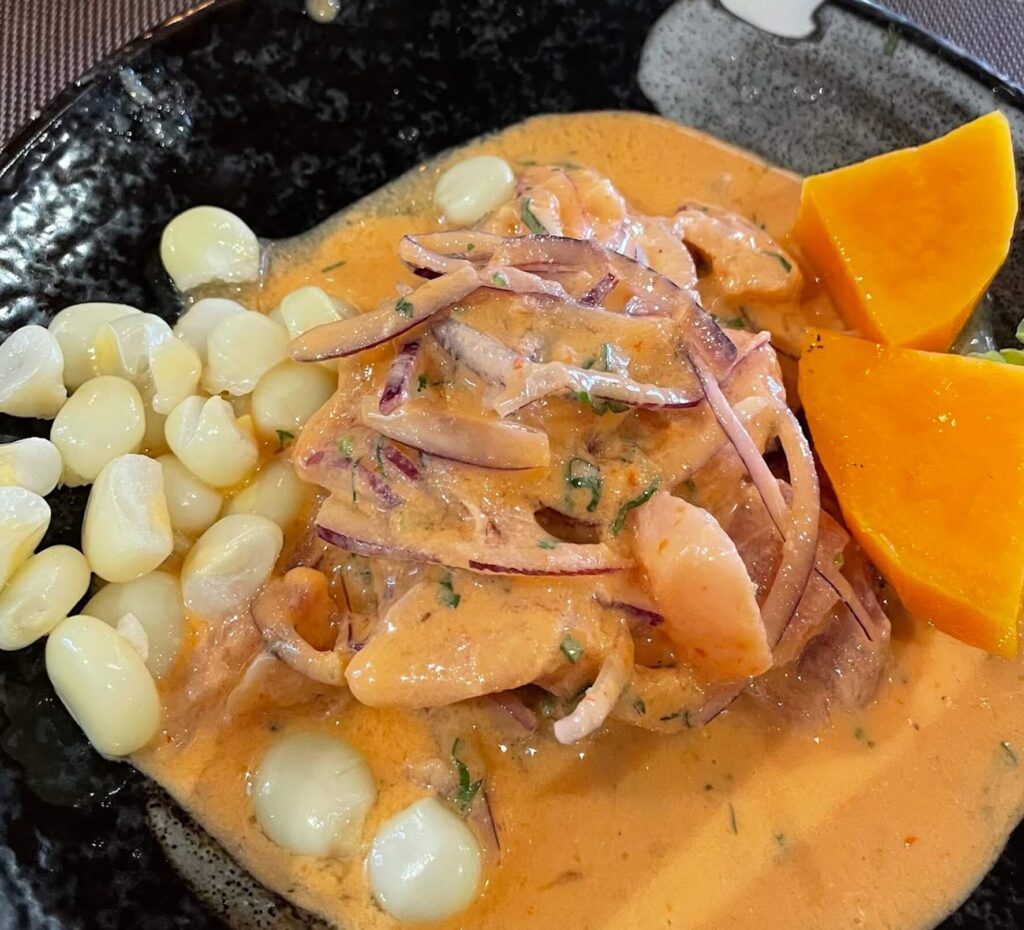
As you might have heard, Peru is famous for its Ceviche, made by soaking tender cuts of raw fish in a mixture of lime juice, thinly sliced red onions and spices, including Peruvian Yellow chilli and Rocoto (this last one is a very spicy red chilli so if you’re not a fan of very hot/spicy dishes, ask your waiter to give you a low-spicy Ceviche!). Some coriander leaves are also sprinkled on this dish.
Tip: Don’t be put-off by the “raw fish” as it tends to get somewhat “cooked” by the acids in the lime juice.
Ceviche is usually served with boiled sweet-potato and Peruvian corn (“choclo”) which is a giant and non-sweet corn version.
Lomo Saltado (sautéed beef)

Lomo Saltado (sautéed beef) is a stir-fry of tender beef cuts, sliced red onions, tomatoes, and Peruvian Yellow chilli (aji amarillo), marinated with soy sauce and other seasonings.
This is one of my favourite dishes, and it’s usually served on top of white rice (we boil our rice with some garlic to add flavour to it!) and home-made “french-fries”. I would definitely recommend you to try Lomo Saltado, and to use the potatoes to soak up the delicious meaty juices!
Aji de Gallina
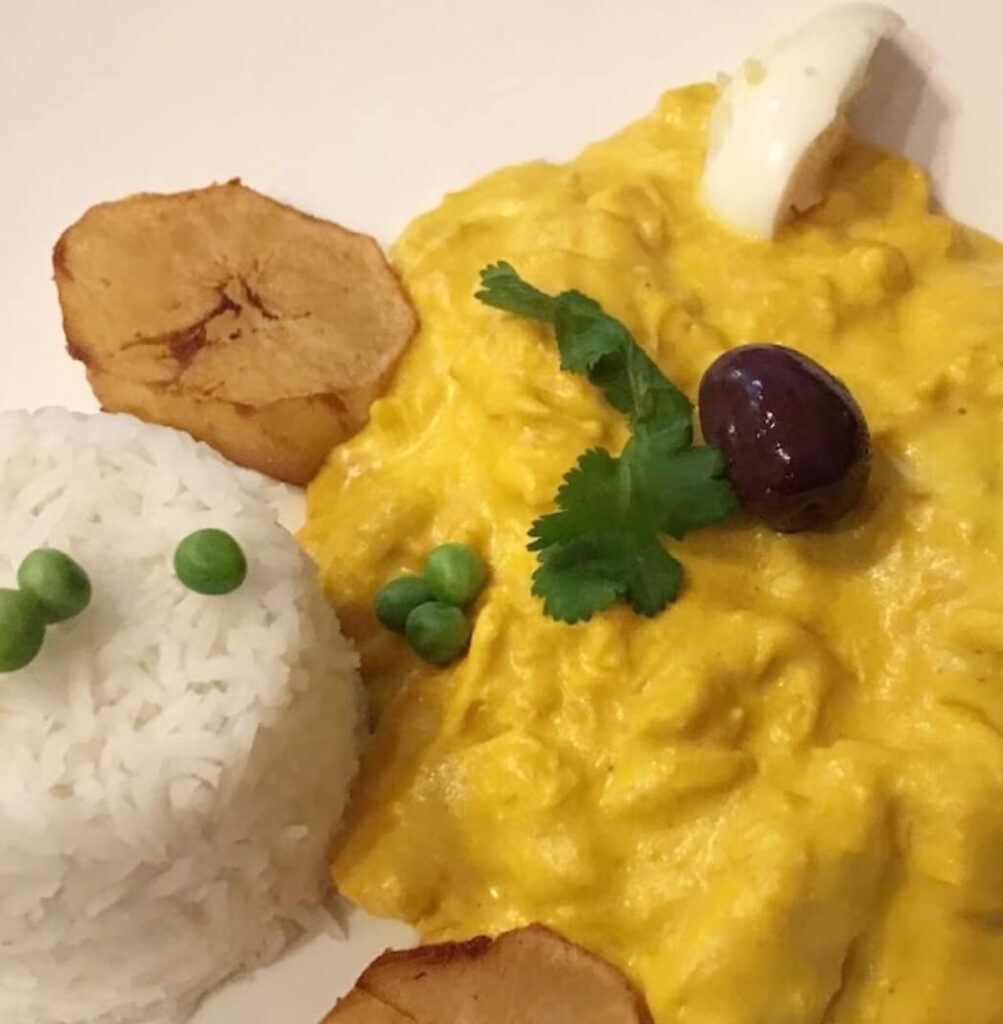
Aji de Gallina stands for “Hen’s Chilli” though contrary to what its name may suggest, this dish isn’t spicy. This yellow-chilli dish is by far one of my favourites and so is the case with many of my friends. You simply can’t go wrong when ordering this plate!
This creamy and savoury dish is somewhat similar in texture to a thick & creamy chicken curry, though the flavours are nothing alike! Aji de Gallina is made by soaking shredded boiled chicken in a creamy mixture of Peruvian Yellow chilli (Aji Amarillo), milk, chicken broth and spices (sometimes it can also include ground peanuts). Bread or crackers are used to thicken the sauce, giving it it’s signature creamy texture.
Similarly to Lomo Saltado, this dish is served with white rice (boiled with garlic) and potatoes (boiled or fried), and is then usually topped with some boiled eggs and a decorative olive (Note the word “decorative” as I don’t like olives :P).
Jalea (deepfried seafood)
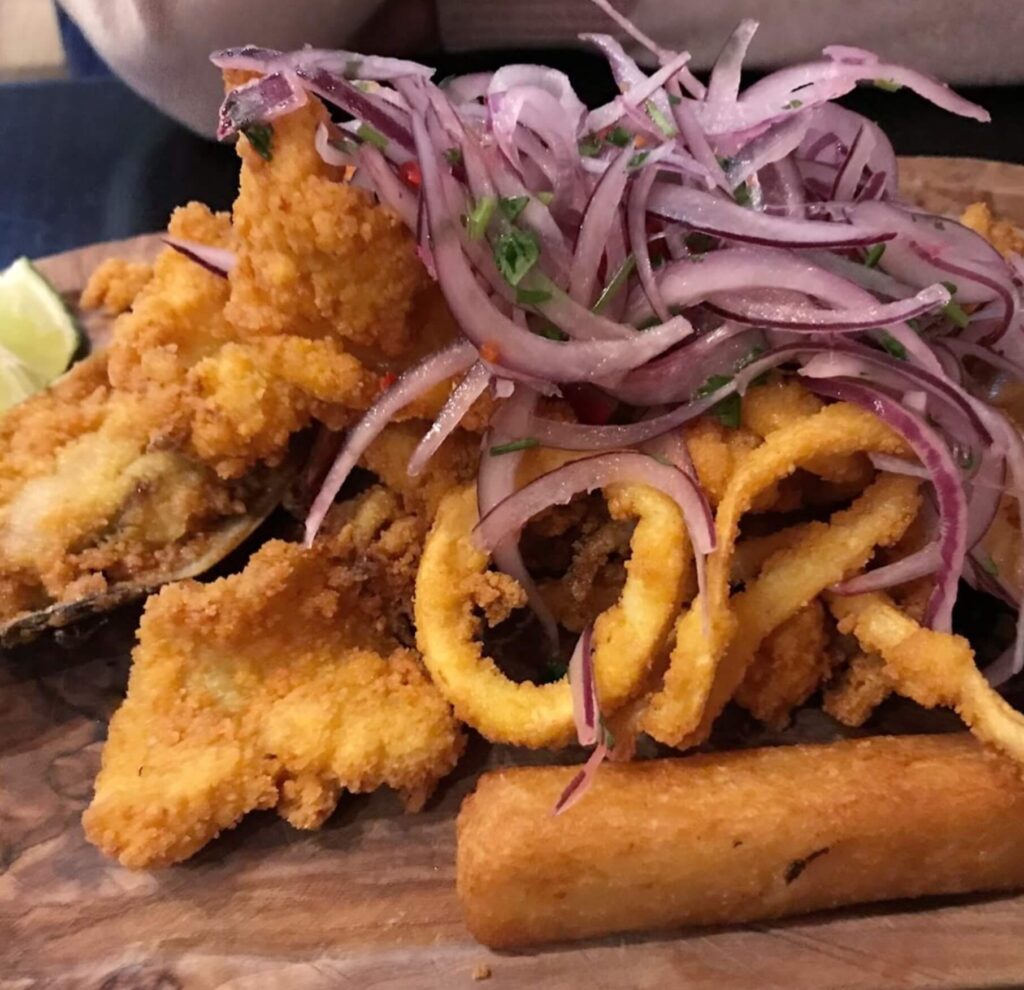
Jalea is a delicious mixture of deepfried seafood including (but not limited to) fish cuts, calamari, shrimps and mussels. Seafood is coated in flour or cornstarch before being deepfried, and is then served with fried Peruvian yams (called yucas), lemon slices, and tartare sauce. It is also often topped with a garnish of sliced red onions, coriander and spices to add more flavour to this plate.
This dish is perfect as a shared platter or can be ordered as a main.
Causa Rellena
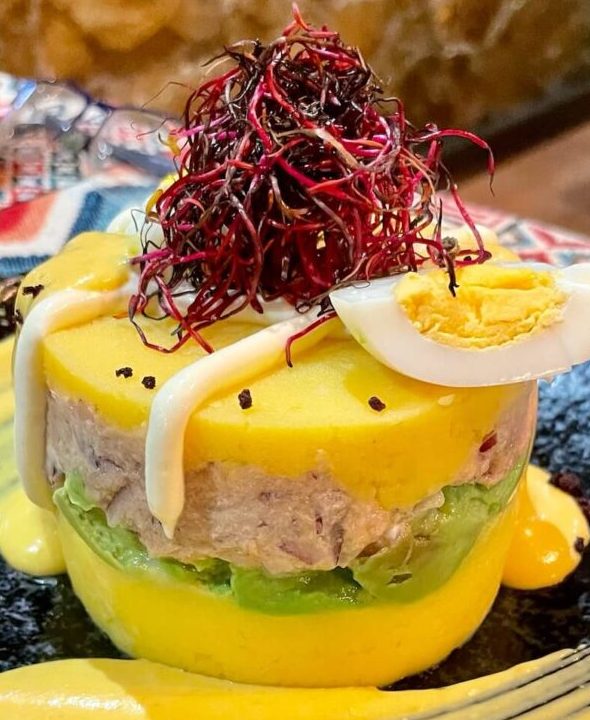
Causa stands for (cold) mashed potatoes mixed with Peruvian Yellow Chilli (“aji amarillo”), lemon juice and oil, resulting in an incredibly tasty mashed potato paste. The mashed potatoes are layered with a mixture of shredded tuna, red onions, avocado, boiled eggs, lime juice and mayonnaise to produce a super tasty cold starter.
If you don’t fancy having tuna, you can ask for a chicken version of Causa Rellena.
Anticuchos de Res (grilled beef heart ❤️)
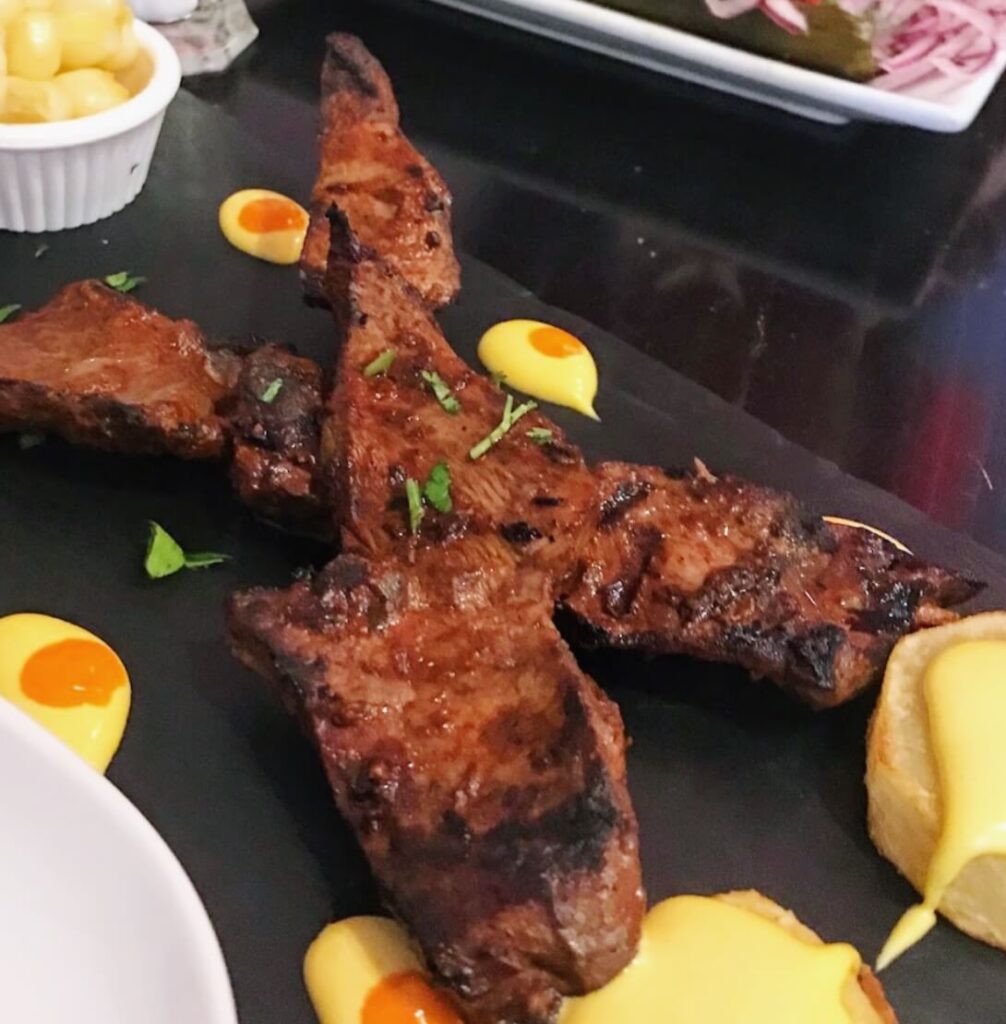
Yes, we eat grilled cow’s hearts in Peru and they are super tasty (though you might want to skip them if you’re a vegan or vegetarian!). “Anticuchos” are a signature street food sold on many Peruvian street corners and served with potatoes, corn and Huancaina Sauce (a.k.a. Cheesy yellow chilli sauce). They were originally served as skewers to make them easier to eat whilst standing on a busy street corner, although the practice of serving them like this has extended to restaurants too.
These skewers are packed with flavour, though they can be a bit too chewy – if you don’t like very chewy food, you might want to give these a miss.
Picarones
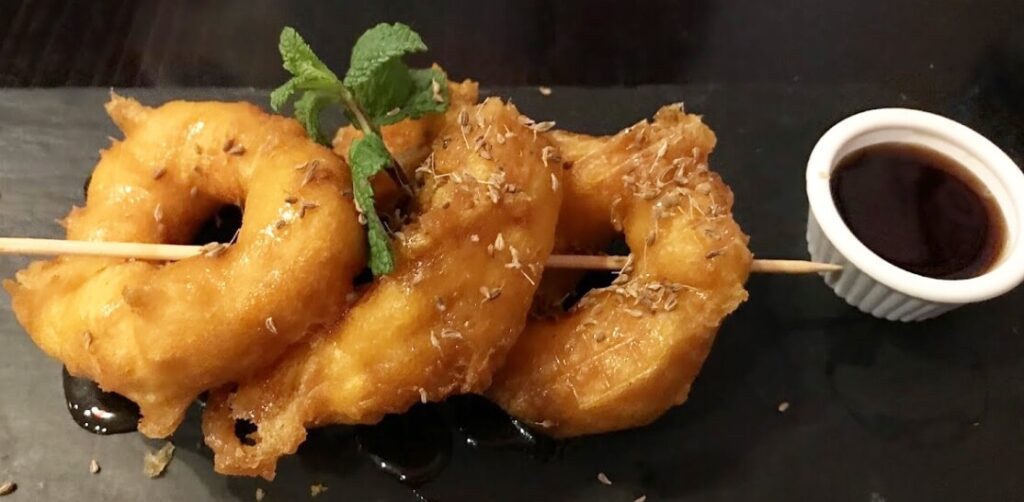
Picarones are tasty, deep-fried desserts sold in many street-corners just as in the case of Anticuchos. Their dough is made of sweet-potato and pumpkin, which is then flavoured with cloves and anise seeds. They’re served as skewers and sided with a very sweet unrefined sugar syrup known as “miel de chancaca”. These are thoroughly delicious and bring back loads of childhood memories of going out with my family to find our closest Picaron food stands.
Peruvian Chinese Cuisine: Chifa
If you fancy some Chinese food with added Peruvian notes, you can try the Peruvianised version of egg-fried rice called Arroz Chaufa. Note our rice comes out slightly brown as we add soy-sauce to it.
Even though Peruvian Chinese food tends to be sold in dedicated Chifa restaurants, it is still common to find Arroz Chaufa in generalised Peruvian food restaurants, albeit with a slightly different (yet still quite tasty) flavour.
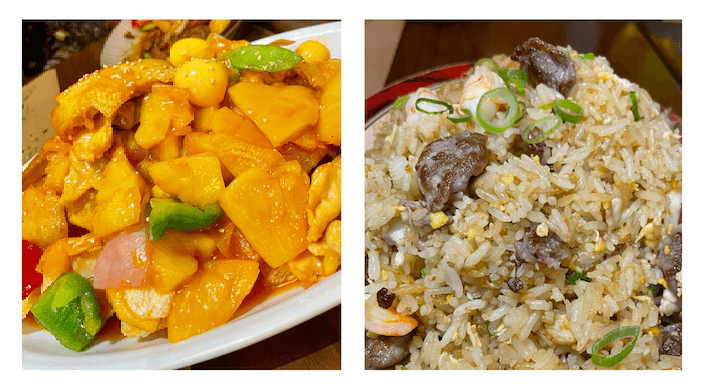
Thanks for reading and hope you enjoyed this post. If you do visit any Peruvian restaurants, let me know how did you enjoy the experience and the food! Also do share this post with your friends and family, to encourage them to try my amazing country’s cuisine!
